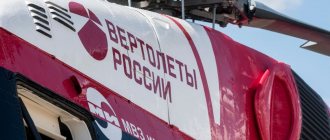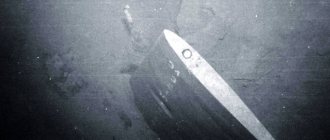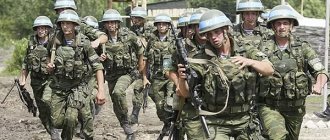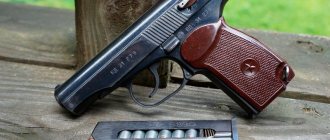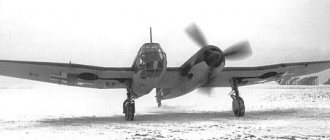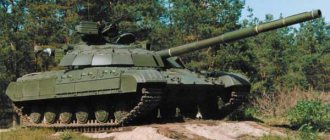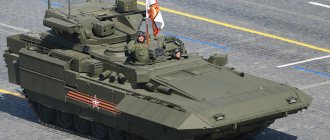Author: zaCCCPanec
12 November 2022 10:48
Tags: Nikolay Kamov aviation helicopters interesting
32485
14
Light, fast, compact, reliable and unusual - these characteristics are ideal for the series of helicopters from the Kamov Design Bureau, which celebrates its 70th anniversary on Sunday. On November 12, 1947, the first aircraft of the famous Soviet aircraft designer Nikolai Kamov, the Ka-8 Irkutsk, took off. This event marked the beginning of the era of helicopters with coaxial rotors.
0
See all photos in the gallery
Russia is still the only state in the world that has established mass production of these complex machines. Kamov helicopters successfully work in “civilian positions” and also serve in army and naval aviation units. About why a coaxial circuit is needed, as well as about its main advantages and disadvantages.
Technical classics
The classic helicopter design provides several fairly simple solutions. The fuselage of the vehicle houses a power plant with a gearbox that produces torque to the main and tail rotors. The main large-diameter propeller is built on the basis of a swashplate, providing changes in lift and/or maneuvering, and also has several high-aspect ratio blades.
This design is relatively simple, it is well developed and can be easily rebuilt and scaled to suit existing requirements. In addition, it does not have some disadvantages, such as the need to seal joints in pipelines or the risk of blades overlapping.
Combat Ka-52. The coaxial scheme, with certain reservations, can be considered a development of the classical one. Photo by the Russian Ministry of Defense
However, there are also disadvantages. A classic helicopter has limitations in horizontal flight speed due to the specific flow around the rotor blades. In some modes, other negative phenomena may occur, such as a vortex ring. If there is one main rotor, it is necessary to construct a long and strong tail boom to accommodate the tail rotor.
The development of the classical scheme led to the emergence of multi-rotor helicopters with longitudinal, transverse or other placement of several load-bearing systems. A coaxial design has become widespread, in which two screws of a traditional appearance are assembled on a single bushing. Also, the classic load-bearing system and a number of its units have become the basis for several alternative designs.
Bell - 206 up to 4 passengers
Bell Helicopter Textron - civil production in Canada, military production in the USA in Texas, multi-role light helicopter with an extended cabin, a Rolls-Royce Alisson 250 gas turbine engine. Easy to fly and operate and capable of performing a wide range of missions. These models hold the safety record among light helicopters, and Bell's helicopter service department has been recognized as the leader over the past 10 years. The main customers of these helicopters are: the US Army and the US Navy. The passenger cabin can comfortably accommodate up to four people; in the rear fuselage there is a separate luggage compartment with a capacity of up to 110 kg. Maximum speed 225 km. h., cruising speed 213 km. h., non-stop flight range 721 km. The maximum flight altitude is 4,025 m, the maximum flight time is 04:30. Salon: length 0.90 m, width 1.65 m, height 1.30 m. Helicopter size: length: 11.82 m, fuselage length 9.5 m, height 2.89 m, main rotor diameter 10.16 m.
Jet propeller
The single-rotor helicopter faces the problem of reaction torque, and various solutions have been proposed to combat it. Back in the thirties, the idea of a jet-driven main rotor appeared almost simultaneously in several countries. Such a propeller is not connected to the engine inside the fuselage and, accordingly, does not force it to rotate in the opposite direction.
Experimental helicopter B-7 in the Monino Museum. An AI-7 turbojet engine is visible on the rear blade. Photo: Wikimedia Commons
The jet main rotor is distinguished by the presence of its own engines at the tips of the blades. The propeller can be driven by a compact turboprop or ramjet engine. Designs with the supply of compressed gases from a gas turbine engine in the fuselage to the nozzles or to the combustion chamber in the blade are also known.
The idea of a jet rotor received quite a lot of attention in the fifties and sixties; A number of pilot projects have been developed in different countries. They were offered as light vehicles like the Dornier Do 32 or V-7 M.L. Mil and the Hughes XH-17 heavy transport helicopter. However, none of these designs progressed beyond small-scale production.
Experienced Hughes XH-17 helicopter. The main engines were responsible for supplying air to the combustion chambers at the blade tip (in the foreground). Photo LIFE / oldmachinepress.com
The main problem with a jet propeller is the complexity of the hub. Through it, compressed gas and/or fuel must be supplied to the movable blade, which requires means of transmission and sealing. It is necessary to place an engine of one kind or another on the blade itself, which places new demands on its design. Creating a reliable design with such capabilities proved to be too difficult and the expected benefits could not justify the effort.
TsKYUBYU 13. bKHMRNYPSHKSHE KERYUREKEMSHE YOOYUPYURSH DPSTSKHU nya, SVEAMSHU KHMYARHRSRRNB X YUBKHYUNMYARPSYRNPNB-KCHAHREKEYpyuanrsh lyuh
bepnker Yu.kh. aNKDSHPEBYU. bEPRNKER I PEYURKHBMSHL OPHBNNDNL MEYASYYETSN BKHMRYU (PHYA. 335) OPNEYRKHPNBUKYA B 1946-1947 CC. X ASHK ONYARPNEM B 1948 Ts. B SWEAAMN-OPNHGBNDYARBEMMNI KYUANPURNPHH lyuh.
ynMYARPSYZHKH BEPRNKERYU, DNBNKEMN OPNYARYU H REUMNKNTSKHVMYU, NRKHVYUKYUYAE MNBKHGMNI REUMKHVEYAYKHU PEEMKHI.
peyuyrkhbmshi bepnker Yu.kh. anKDSHPEBYU KHLEK OPNYAREIESCH OKHPYULHDUKEMSCH PYULS HG DSPYUKCHLHMNBSHU RPSA YAN YARYUKEMSHLH BYARYUBYULH B LEYARYU YPEOKEMH. b EE BEPUMEI VYUYARKH PUYAONKNFHKH YAHKNBNI SGEK YPEOKEMKH MEYASYYETSN BKHMRYU, B YAPEDMEI - VYUS-YAHDEMEEE OHKNRYU, YU NYAMNBYUMKHE PYULSH BSHONKMHKH B BHDE NONPSH MNYANBNTSN YNKEYAYU X DBSU UBNYARNBSHU YNYARSHKEY, PUGMEYEMMSHU MU 1.2 L. ON NYAH YNKEYAYU SYARYUMNBHKH MEONDBHFMSHE OEDYUKH-ONDMNFYH. yLNPRKHGYURNPYULH YAKSFHKH OMEBLURKHYH DHYULERPNL 250 LL X YNYARSHKH, BREAD GMYUVHREKEMSCH DKHMS X DNYURRNVMSCH SHKYUYARKHVMNYARE YNMZHEBSHU SVYUYARYNB.
YNMZHEBSHE VYUYARKH YNYARSHKEY YABGYUMSH I BEPRKHYUKEMSHLH NONPYULH PYULSH (BEPUMEI ITS VYUYARKH) RPNYYULH. rPESCNKEMHYH, NAPYUGNBYUMMSHE RPNYYULH, BEPRKHYUKEMSHLH NONPYULH KH RPSAYULH YNYARSHKEY, NARJMSRSHE TSEPLERKHVMNI RYUMECH, NAPYUGNBSHBUKH BEPRHYUKEMSHE YARYUAHKHGHPSCHYKH E ONBEPUMNYARKH - PYYYAYOEKEMMSHE YHKH.
MEYASYYU YAHYARELYU YANEDHMKYUYAE I PYULNI BEPRNKERYU B BEPUMEI ITS RNVYE I ONLNYECH YUPDYUMMNTSN YUPMHPYU. nYAE BKHMRYU SDKHMEMMYU. y MKhFMEI ITS VYUARKH S YUPDYUMMNTSN YUPMHPYU YPEOHKYUYAE PSVYU SOPYUBKEMKH BEPRNKERNL, YU MU BEPUMEL YNMZHE - BRSKYU BKHMRYU. LEFDS YUPDYUMMSHL YUPMHPNL X BRSKYNI BKHMRYU PYYAONKNFEM RNOXBMSHHI AYU SHKKKHOYANKHDMNI TNPLSH. nYAE BHMRYU BSHONKMEMU ONKNI. VEPEG MEE RNOKKHBN ONDUBUKNYAE ON RPSANOPNBNDYUL Y DBKHTSUREKIL, SYARYUMNBKEMMSHL ON YNMJUL DBSUKNOYARMNTSN MEYASYETSN BKHMRYU.
pCN. 335. bEPRNAKER Yu.kh. aNKDSHPEBU (YU) KH ETSN YAUELU (A)
MU YNMZHE PSVYKH SOPYUBKEMKH BEPRNKERNL HLEKYUYAE ONBNPNRMYU PSYNRYYU LNRNZHHYKERMNTSN RHOYU, NR YNRNPNI YEK TSHAYKHI RPNYA DNGHPSCHYEI KHTSKE, SYARYUMNBKEMNI B ZHEMRPU KEMNL RNOXBMNL YUMYUKE B NYAH BHMRYU. ONBNNPNR PSYNRYKH PETSSKHPNBYUK ONYARSOKEMKHE RNOXBYU B DBKHTSUREKH, ONDUBUELNTSN OPH ONLNYH ZHEMRPNAEFMNI YAHKSH. rNOKHBMSHU MUYANYANB ME ASHKN.
NPHTSKHMYUKEMNI ASHKYU YNMYARPSYZHKH BRSKYKH BKHMRYU. kNOYUYARKH, KhGTSNRNBKEMMSHE MU PELNMRMNI AYUGE bbya, YPEOHKH Y BRSKYE I ONLNYECH BEPRKHYUKEMSHU YUPMKHPNB, NYAEBSHU YUPMKHPNB NMH ME HLEKH. TsNPKHGNMRYUKEMSHI YUPMHP ASHK NDHM MU DBE KNOYUYARKH. pYYYAONKNFEM NM ASHK OND STSKNL 4th NYAH KNOYUYAREI. ryuine SYARPNIYARBN BRSKYKH NAEYAOEVKHBUKN YUBRNLYURKHVEYAYNE SOPYUBKEMKHE NAYKHL YUTsNL BKHMRYU, VRN GMYUVHREKEMN SOPNYYUKN YNMYARPSYZHCH H ME RPEANBUKN NRDEKEMNTSN YNLYUMMDN- YNMRPNKEMNTSN PSHVYUTSIU SOPYUBKEMKH.
yUBRNLYURKHVEYAYNE SOPYUBKEMKHE NAYKHL YUTsNL BKHMRYU NYASYYARBKKNYAE YAKEDSCHYHL NAPUGNL. mu LYUYAKHLYUKEMNL VHYAKE NANPNRNB (LYUYAKHLYUKEMNI LNYNNYARKH DBKHTSYUREKEY) ZHEMRPNAEFMYU YAHKYU KNOYUYAREI MYUHANKEYU, YNMSYA, NLERYUELSHI KNOYUYARLKH, AKKHGNY Y DKHYAYS. b SCHRNL YAKSVYUE SCSC SYARYUMNBYKH KNOYUYAREI LYUYAHLYUKEMSHI - PYUYAVERMSHI. YNTsDU LNYMNYARE DBKHTSUREKEY SLEMEYUCHR, OYUDUER ZHEMRPNAEFMYU YAHKYU KH STsNK YNMSYU NLERYUELNTSN KNOYUYARLKH MEYASYYETSN BKHMRYU SBEKHVKHBUERYA. OPH SCHRNL KNOYUYARKH, ONDMHLYUYAE BBEPU NRMNYAHREKEMN YNYANTSN YUPMHPYU, SLEMEYUCHR YABNI SYARYUMNBNVMSHI SCSC. b YAKSVYUE YUBRNPNRYUZHKH YNMSYAMNYARE MEYASYYETSN BKHMRYU MEANKEYU, SYARYUMNBNVMSHI STsNK KNOYUYAREI YUBRNLYURHVEYAYKH YARYUMNBKHRYA MYUKHLEMEHL -0╟. mu PYUGPYUANRYS RUYNI YNMYARPSYZHHH MEYASYYETSN BHMRY BEPRNKERYU yu.kh. aNKDSHPEBS ASHKN BSDHYUMN YUBRNPAYNE YABKHDEREKEYARBN.
onKSHE KNOYUYARKH BKHMRYU BEPRNKERYU, YANTSMRSHE XG DSPYUKCHLHMNBNTSN KHYARYU H YAYKEOYUMSHE ON KNMFEPNMS (o-NAPYUGMNLS I NRANPRNBYNI), HLEKH OPNYARSCH YNMYARPSYZHCH. ON MHL BNGDSU NR YNLKEBNI VYUYARKH, TsDE ASHKH YADEKYUMSH NRBEPIARKH, ONYARSOYUK Y OPLNRNVMSHL PEYUYRKHBMSHL DBKHTSUREKIL.
mu BEPRNKERE SYARYUMNBHKH DBYU OPILNRNVMSHU DBSUYNMRSPMSHU PEYURKHBMSHU DBKHTSUREK YNMYARPSYZHHH yu.kh. aNKDSHPEBYU, HL FE KhGTSNRNBKEMMSHE. pyuyavermyu rtsyu dbkhtsyurek 4 YTSYA (40 m). dK HYAOSHRYUMKHI X NRPYUANRYKH DBKHTSYUREKEI MU GELKE YAOPNNEIRKHPNBUKH X KHGTSNRNBKHKH YAOEZHHYUKEMSHI YAREMD I OPHMSDHREKEMNI ONDUVEI BNGDSUYU B DBKHTSYUREKE. MU YAREMDE GYULEPKHYAE RYTSYU H RELOEPYURSPYU DBKHTSYUREK, PYYAUNDSH BNGDSUYU H RNKOKHBYU. dBHTSUREKH MYUPYUANRYUKH MU YAREMDE OH 4.5 V. rtsyu OPH HYAOSHRYUMKH MU YAREMDE ASHKYU DNBEdemyu DN 3.5 YTSYA (35 m). yNMYARPSYZHKH DBKHTSYUREK ONGBNKHKYU SBEKHVKHRE OPHLEPMN BDBNE PUYAUND BNGDSUYU H, YAKEDNBUREKEMN, iodine, YNRNPSHY S OPLNRNVMNTsN DBKHTSYUREK MU DNGBSYNBSHU YAYNPNYA RYU DNBNKEMN MHGYKHI. yPNLE RNCN, ONDYUVYU BNGDSUYU VEPEG KNOYUYARKH YAMHFYUKYU OSKEYYUZHCH DBKHTSYUREK, RYU YUY BNGDSU, MUAYETSYUCHYKHI MU BUNDMNE YANOKN, YEK ME ON NYAH DBKHTSYUREK, YU OND STSKNL Y ME I X, YPNLE RNCN, BHAPHPNBUK. dBKHTSYUREKE ASHK NPHTSKHMYUKEMNI KH DNBNKEMN YAKNFMNI YNMYARPSYZHKH. mu METSN yu.kh. aNKDSHPEB ONKSVHK YUBRNPAYNE JABHDEREKEYARBN MU KHGNAPEREMKHE.
peyuyrkhbmshi bepnker Yu.kh. anKDSHPEBYU KHLEK GYUOYUYA TSNPCHVETSN MU 15 LHM ONKERYU. pyuyavermu BEPRKHYUKEMYYAYNPNYARE S GELKH - 2 L/Ya. yNMYARPSYZHKH ASHKYU BSHONKMEMY YAYKYUDSHBUCHYYYYYYYYYYYYYYYYYYYYYYYYYYYYARPSYZHKH b YAKNFEMMNL BHDE BEPRNKER KHLEK TSYUAYUPHRMSHE PYUGLEPSH 0.5×0.8×2.2 L, R.E. ASHK DNBNKEMN YNLOYURMSHL.
sOPYUBKEMHE BEPRNAKERNL ON YPEMS, RYUMTSYUFS KH B OSREBNL MYUPYUBKEMHH NYASYYARBKKNYAE MEONYAPEDYARBEMMSHL NRYKNMEMHEL B MSFMSCH YARNPNMS NYAH BPYUYYEMH MEYASYETSN BKHMRYU. bHMR YPEOKHKYA Y BEPRNKERS MU YUPDYUMMMNL YUPMHPE KH NRYKNMYKYA I ONLNYECH PSVYKH SOYUBKEMKH. sOPYUBKEMKHE NAYKHL YUTSNL BKHMRYU NYASYYARBKKNYAE YUBRNLYURKHVEYAYKH OPH HGLEMEMHKH RITSKH PEYUYRKHBMSHU DBKHTSYUREKEY.
ONYAKE YANPHYH PETSKKHPNBYKH BEPRNKER OPNYEK HYAOSHRYUMKH B PEFHLE YUBRNPNRYUZHKH B YUSCHPNDKHMYULKHVEYAYNI RPSAE. GYUREL BEPRNKER HYAOSHRSHBUKH YUY YUBRNFHP, ASYAHPS KETSINBSHL YUBRNLNAKHKEL. schRN OPNHYAUNDHKN B LNYAYNBYAYNI NAKYYARKH B PYYINME oYUBHMY. aSHKH MEANKEKHE ONDKERSH. xYAOSHRSHBUK BEPRNKER Yu.kh. aNKDSHPEB. bN BPEL OPNAEFYKH MU ASYAHPE BEPRNKER ASHK MESYARNIVHB. ShRN NAZYAMKNYAE ANKEHL BSHMNYANL YNKEYAYU BOEPED. xYAOSHRYUMKH ME ASHKH GYUBEPYEMSH. Yu.H. aNKDSHPEB ONKSVHK NR m.kh. yYULNBU OPEDKNFEMHE OPNDNKFHRE PYUGPYUANRYS SCHRNTSN BEPRNKERYU.
b 1955 Ts. Yu.kh. aNKDSHPEB PUGPYUANRYUK OPNEIR RPEULEYARMNTSN PEYURKHBMNTSN BEPRNKERYU. ECN OPNEIR SRBEPDHK YYUDELKHY a.m. hPEEB. bEPRNKER DNAFEM ASHK KHLERE: DHYULERP DBSUKNOYARMNTSN BKHMRYU 7 L, ONKERMSCH LYUYAAS 550 YTS, LYUYAAS YNMYARPSYZHKH 170 YTS. oPEDONKYUTSYUKNYAE, VRN MYUTSPSGYU MU NLERYUELSCH BHMRNL OKNYYUDE DNAFMYU YANYARYUBKJRE 14 YTSYA/L2, MYUTSPSGYU MU SHCHYBKHBUKEMRMSC LMNNYARE -5.5 YTSYA/K.YA. (7.48 YTSYA/YbR), LYUYAKHLYUKEMYU YAYNPNYARE - 20 YL/V, YAYNPNONDZELMNYARE - 3 L/YA, PUYAVERMYU ROTSIU NDMNTsN DBKHTSYUREK - 15 YTsYA (150 m).
xGTSNRNBHKH OPNDSBNVMSCH LNDEKE X OPNBEKH EE YUSCHPNDHMYULHVEYAYHE HYAYAKEDNBYUMH. bePRNKER KHLEK UNPNNKHE PYYAVERMSHE KERMN-REUMHVEYAYHE DYUMMSHE, MN OPNEIR ME ASHK NYASYYYARBKEM.
yaBEPUKETSYKHI YUBRNFHP t.o. ySPNVIHMYU. b 1947 Ts. BSHOSYAMHY lyukh t.o. ySPNVIYHM OPNBEK YUSCHPNDHMYULHVEYAYHE HYAYAKEDNBYUMH LNDEKH YABEPUKETSINTSN KHMDHBKHDSYUKEMNTSN YUBRNFHPYU. lNDEKE B LYUYARYUAE 1:5 OPEDYARYUBKYU YANANI LYUMEYEM KSHFMHYU I SIPEOKEMMNI MU MEL ONDBEYAMNI YAHYARELNI PYUMZHEBNTSN RHOYU. th MEI MU YARNIYU YPEOKHKYA MEYASYKHI BKHMR-PNRNP YUBRNFHPYU. lNDEKE HYAOSHRSHBUKH B YUSCHPNDKHMYULKHVEYAYNI RPSAE r-1 bNEMMN-BNGDSSMNI YYUDELXX HL. m.e. fSINBEYNTZN. nMYU SYARYUMYUBKHBUKYUYAE B PUANVEI VYUYARKH RPSASH I ONLNYECH RNMYNI YARYUKEMNI OPNBNKNYH DKHMNI 4 L, KHLHRKHPPNBUBEI ASYAKHPNBNVMSHI RPNYA, X YPEOHKYUYAE Y ONKS RPSASH. oPH SBEKKHVEMKH YAYNPNYARKH ONRNYU B RPSAE "xBYUM" (RYU HYAYAKEDNBUREKH MYUGSHBYUKH YABNETSN KSHFMHYU) BGKERYUK KH SYARNIVKHBN DEPFYUKYA B BNGDSUE, SDEPFKHBUELSHI NR TsNPKHGNMRYUK EMNTsN OEPELEYEMKH YARYUKEMNI OPNBNKNYNI. dK GYULEPYU ONRPEAMNI RTTSKH (YANOPNRKHBKEMKH YUBRNFHPYU) OPNBNKNYS ONDIANEDKHMKKH Y OPSFKHMMSHL BEYAYUL. lNDEKE KCHAKHK DELNMYARPHPNBURE YYUDELKHY a.m. hPEEB. dK DELNMYARPUZHKH SARNIVKHBNYARKH YOOYUPYURYU NM VEPEG KCHVNY B RPSAE SYUGYNI RNKYUK LNDEKE B YARNPNMS. nMYU ONYAKE MEYAINKEIKHU YNKEAYUMKHI OPNDNKFYUKYU SARNIVHBSHI “ONKER”.
MU NYAMNBYUMHH HYAYAKEDNBYUMHI ASHK ONYARPNEM MYURSPMSHI KERYUREKEMSHI YOOYUPYUR t.o. ySPNVIHMYU (PHYA. 336). yuBRNFHP KHLEK ONDBEYAMSC YAKHYARELS OYUPYUCHRMNTSN RHOYU I MEANKEHL YAKHDEMEEL MY MHFMKHU KOLYUU. th ONDBEYAMNI YAHYARELE YPEOKHKHYAE YARNIIKH, MU YNRNPSHU SYARYUMNBHKH BRSKYS MEYASYETSN BKHMRYU. mu NYAH BRSKYKH BPYUYUKYA RPEUKNOYYARMSHI BCMR. nYAE BKHMRYU ASHKYU BSHONKMEMYU B BHDE RPSASH, YAYBNGE YNRNPSCH OPNUNDHK BEPUMKHI YNMEZH PSVIKH SOYUBKEMKH. MU BEPUMEL YNMZHE PSVYKH SOPYUBKEMKH, MYUD OKNYAYNYARECH BPYUYYEMH BKHMRYU, PUYAONKNFHKH DKHYAY YUBRNLYURYU OPEYNYAYU. pSVYU SOPYUBKEMKH YUPMKHPMN YPEOHKYUYAE Y BEPUMEI RNVIE RPSAVIURNI NYAH MEYASYETSN BKHMRYU. oHKNR DEPFYUK B PSYE MHFMHI YNMEZH PSVYKH SOPYUBKEMKH KH NRYKNMJK B RS XKH DPSTSCH YARNPNMS DKHYAY YUBRNLYURYU OEPEYYU, VRN OPKHBNDHKN Y ZHYKHVEYAYNLS HGLEMEMHCH STSKNB SIA RYUMNBYKH KNOYUYAREI BKHMRYU. kNOYUYARKH YPEOHKHKYAE Y BRSKYE BKHMRYU TsNPKHGNMRYUKEMSHLH H NYABSHLH YUPMKHPYULH. mu BRSKYE (MHFE OKNYAYNYARH BPYUYEMH BKHMRYU) SYARYUMNBHKH AYUPYUAYUM DK MYULNRYH RPNYU OPHMSDHREKEMNI PUYAYPSRYH BKHMRYU.
OEPED OKHKNRNL MU YPNMYREIME ASYAKHPNBNVMNTSN RPNYU PYYAONKYUTSYUKHYAE SYUGYUREKE YAYNPNYARKH, BYUPHNLERP KH GYULNY NRZHEOYKH.
kNOYUYARKH YUBRNFHPYU HLEKH YALEYUMMSCH YNMYARPSYZHCH. mu HU LERYUKKHVEYAYHI KNMFEPNM SYARYUMYUBKKHBUKH TYUMEPMSHE MEPBCHPSH. ON OEPEDMEI YPNLYE KNOYUYARKH NAHKKH LHKKHLERPNBNNI TYUMEPNI, YABEPUS KH NARJMSKH ONKNRMNL X ONYPSHKH YUSCHPNKYYNL.
yNMYARPSYZHKH YUBRNFHPYU BSHONKMEMY YAANPMN-PYUGANPMNI. b PUGNAPUMMNL BKhDE NM SYKYUDSHBUKYA B OEMYUK DHYULERPNL 0.4 L X DKHMNI 2.5 L.
pCN. 336. so ySPNVIYHM I YUBRNFHPNL YANAYARBEMMNI YNMYARPSYZHHH
hYAOSHRSHBUKH YUBRNFHP, ASYAHPS TsPSGNBKHYNL tsyug-yuyu MU RPNYAE DKHMNI 25 L.
nVEME KHMREPEYAMNI ASHKYU YAHYARELYU PUYAYPSRYKH MEYASYETSN BKHMRYU. yaBNANDMSHI YNMEZH RPNYU YPEOHKH MU GELKE (MYUOPHLEP, Y BUPRNBNVMNLS RNONPS). OPH PYUGAETSE RPNYA, MYULNRYUMMSHI MU AYUPYUAYUM, PYYAYPSVKHBYUK MEYASYKHI BCMR DN MENAUNDHLNTSN VHYAKYU NANPNRNB. ONYAKE OPNAETSIU B MEYAINKEIN TYUTSNB YUBRNFHP BGKERYUK MU BSHIANRS 7...8 L YAN YAYNPNYARECH 45 YL/V. oEPBSHHE ONKERSH ONYUGYUKH UNPNKHE SYARNIVKHBNYARE KH SOPYUBKELNYARE YUBRNFHPYU, MN, Y YANFYUKEMKHCH, HYAOSHRYUMKH DN YNMZHYU ME ASHKKH DNBEDEMSH. xYAOSHRSHBUK YUBRNFHP ETSN YNMYARPSYRNP X PYUGPYUANRVKHY t.o. ySPNVYHM B 1948 Ts. OND lNYAYBNI B PUINME OKYURTNPLSH YANYNKNBYAYU.
yUBRNFHP ySPNVIYKHMY OPH DUKEMEYEI ETSN DNBNDYE KH SYARYUMNBYE KETSYNTSN DBKHTSUREK I RNKYUCHYHL BKHMRNL LNTs ASH MUIRKH YAONPRKHBMNE OPHLEMEMKHE.
pYUANRSH YNLYANLNKEYAYN-LNKNDEFMNTSN ya VEKAHMYAYNTSN LYUGYUBNDYU
b 1958-1960 CC. B VEK'AHMYAYE MU LYUHMNYARPNHREKEMNL GYUBNDE ASHKN NPTSYUMKHGNBUMN YNLYANLNKEYAYN-LNKNDEFMNE ya, YNMYARPSYRNPSH YNRNPNTsN OND PSYNBNDYARBNL a. lSHYANBU YAOPNNEIRKHPNBUKH RPH BHMRNYPSHKSHU KERYUREKEMSHU YOOYUPYURYU.
oEPBYU PUANRYU ya - YUBRNFHP-OKYUMEP a. lSHYANBU X part VEYAYKHDNBU (PHYA. 337). xYAOSHRYUM NYAEMECH 1959 Ts. aSYAKHPSELSHI LNRNZHHYKNL l-72, YUBRNFHP BGKERYUK MU YAYNPNYARKH 40 YL/V. bN BPEL PYUGAETSIU MEYASYKHI BCMR YUBRNFHPYU PUYAYPSVKHBUKYA B REVEMKHE 10 I DN 120 NA/LHM I ONLNYECH PEYURKHBMSHU SYAYNPHREKEY, PUYAONKNFEMMSHU MU YNMJUU KNOYUYAREI.
b ya ONYARPNHKH NDMNLEYARMSHI YUBRNFHP (PHYA. 338) I LNRNZHHYKERMSHL DBSUZHKKHMDPNBSHL DBHTSUREKEL X RNKYUCHYHL BHMRNL. tCHGEKЪF - TEPLEMMNI YNMYARPSYZHKH I BEPRKHYUKEMSHL X TSNPHGNMRYUKEMSHL NOPEPEMHEL. yuYAYAH - DBSUINKEYAMNE I UBNYARNBNI NONPNI.
b ya PYUGPYUANRYUKH, YPNLE RNCN, PYUMZHEBSHI PEYURKHBMSHHI BEPRNKER I DBSUKNOYUMSHL MEYASYKHL BHMRNL I PEYURKHBMSHLH DBKHTTSUREKLKH MU YNMZHYUU ECN KNOYUYAREI.
yNMYARPSYRNPSH ya YADEKYUKH PUANVHI OPNEIR DBSULEYARMNTSN YUBRNFHPYU I YUAHMNI YUBRNLNAHKEMNTSN RHOYU I LNRNZHYKERMSHL DBKHTSUREKEL LMNNYARECH 57 K.Ya., DBSUYKHKEBSHL NOPEMPHEL MU UBNYARNBNI AYUKYE (PHYA. 339).
pCN. 337. oKYUMEP-YUBRNFHP a. lSHYANBU X h. WEYAYKHDNBU
pCN. 338.
pCN. 339. oPNEYR DBSULEYARMNTSN YUBRNFHPYU
pYUANRSH ySyukh X yuh
bEPRNKER "bHUPE". nDMNLEYARMSHI BEPRNKER "bHUPE" (PHYA. 340) I DBSUKNOYARMSHL MEYASYHL BKHMRNL ASHK ONYARPNEM B 1962 Ts. NTsN YUBKHYUZHNMMNTsN KHMYARKHRSRRYU (ySyukh) OND PSYNBNDYARBNL h. mu YNMZHYU KNOYUYAREI MEYASYYETSN BKHMRYU YARNKKH OPILNRNVMSHE BNGDSMN-PEYURKHBMSHE DBKHTSUREKH YAN YARYURKHVEYAYNI RTsNI NYNKN 2 YTSYA (20 m).
TsNPCHVEE HG RNOKKHBMNTSN AYUYU, PUYAONKNFEMNTSN OND YAHDEMEEL OHKNRYU, ONDUBUYUKNYAE OND DYUBKEMHEL VEPEG ONKSHE KNOYUYARKH BKHMRYU Y DBKHTSUREKIL. yuYAYAH RPEUYNKEYAMNE. oEPEDMEE YNKEYAN YAYULNNNPHEMRKHPSCHIEEE. sOPYUBKEMKHE BEPRNKERNL MEONYAPEDYARBEMMNE - NRYKNMEMHEL OKNYAYNYARKH BPYUYEMKH MEYASYETSN BKHMRYU. pSVYU SOPYUBKEMKH "YUTS-TSUG" NRYASRYARBNBUKYU. sOPYUBKEMKHE YUTSNL MEYASYYETSN BKHMRYU YUBRNLYURKHVEYAYNE - I ONLNYECH OPNYAREIEI YUBRNLYURKHVEYAYNI BRSKYKH BKHMRYU (YUY S BEPRNKERYU Yu.H. ANKDSHPEBYU). BRSKYU HLEKYU NAYKHI TSNPKHGNMRYUKEMSHI YUPMHP, SYARYUMNBKEMMSHI OND STSKNL 45╟ YNYAKH DBSUKNOYUARMNTSN MEYASYYETSN BKHMRYU. I SBEKKHVEMHEL VHYAKYU NANPNRNB (SBEKHVEMKHE “TSYUGYU”) SBEKHVKHBYUKYA SCNK YURYUYKH KNOYUYAREI. yu YNTsDYu "TSYUG" ASHK LHMKHLYUKEMSHL, KNOYUYARKH OPHONDMKHLYUKHYAE NRMNYAHREKEMN TsNPKHGNMRYU BBEPU KH YUBRNLYURKHVEYAYKH SYARYUMYUBKHBUKKHYAE MU MSKEBSHE STSKSH YURYUYKH. bEPRNKER AEGNOYUYAMN YUBRNPNRKHPNBUK.
pCN. 340. bEPRNKER “bHUPE”
kNOYUYARKH KGTSNRNBKH KH DSPYUKCHLHMNBNI RPSASH YUOKENAPYUGMNTSN OPNTHK I OPHYKEEMSHL Y MEI UBNYARKHYNL KNOYUYARKH KH RNMYNTSN DSPYUKCHLHMNBNTSN KHYARYU. bEPRNKER HLEK NRYPSHRSC YUAHMS. UBNYARNBNE NOEPEMKHE, BSHMEYEMNE MU RPSAVIURSCH UBNYARNBSCH AYUKYS, YANYARNKN KH YHK I PSKEL MYUPYUBKEMKH.
yuh-24. b 1963 Ts. lSHYANBYU. gyu DBYu TsNDYu YARSDEMRSH-YNMYARPSYRNPSH YAOOPNEYRKHPPNBUKH KH ONYARPNHKKH MEYAINKEIN NOSHRMSHU NAPYUGZHNB BEPRNKERNB KH YUBRNFHP.
pCN. 341. yaUELU YUBRNFHPYU yuh-24
yuh-24 (PHYA. 341) - OEPBYU B UPNMNKNTSKHVEYAYNL ONP'DYE PYUANRY BEPRNKERMNI TsPSOOSH yaya. dBSULEYARMSHI YUBRNFHP yuh-24 ASHK YAOPNEYRKHPNBYUM KH TsNRNBKEM DNBNKEMN ASHYARPN a. lSHYANBSHL, b. HYSYNL, b. yaEPYN X DPSTSHLH B 1965 C.
yuBRNFHP KHLEK LERYUKKKHVEYAYSCH YNMYARPSYZHCH. YYUAHMS YADEKYUKH GUYPSHRNI I NAYYEI DK DBSU OKHKNRNB DBPECH, NRYPSHBUCHYEIYE BBEPU. YAHDEME PUYAONKNFHKH NDMN GYU DPSTSHL.
dBKHTSUREKE LNYMNYARECH 140 K.Y. (102.9 YbR) SYARYUMNBHKH B OEPEDMEI VYUYARKH TCHGEKKFYU. yuYAYAH - MESAKHPUCHYEEYEYE, RPEUNONPMNE, I MNYANBSHL YNKEYANL. MEYASYKHI BKHMR - RPEUKNOYYARMSHI. dBSUIKHKEBNE BEPRKHYUKEMNE NOEPEMKHE BSHMEYEMN MU UBNYARNBSC AYUKYS. yuBRNFHP KHLEK UNPNNKHE YUSCHPNDKHMYULKHVEYAYKHE TNPLSH. nM SHYYAONMHPNBYUKYA B 1966 Ts. yNKKEYRHB yaya ASHK MYUTSPYUFDEM GNKNRNI, YAEPEAPMNI KH RPEL APNMGNBSHLH LEDYUKLH GYu ShchRS PYUANRS.
bEPRNKERSH X YUBRNFKHPSH YUBKHYUNMYARPSYRNPNB-SHMRSGKHYYARNB
pYUANRSH YNMYARPSYRNPNNB lNYAYBSH. b 1949 C. B LNYAIBE ch.k. YARYUPKHMHM YAOPNEIRKHPNBUK YABEPUKETSYKHI BEPRNKER "l" NDMNBKHMRNBNI YAUELSH I OPHBNDNL DBSUKNOYUYARMNTSN BKHMRYu NR OSKEYAHPSCHYHU bpd, SYARYUMNBKEMMSHU MU YNMJUU KNOYUYAREI. pYUANRSH BEKHYAE YANBLEYARMN I ch.ya. aPYUTSKHMYAYHL. MAINRNPSHE SGKSH X DERYUKH KHTsNRNBKEMSH B GYUBNDYAYKHU SYAKNBHYU. MU SYARPNIYARBN NDMNYUPMKHPMNTSN BKHMRYU I OSKEYAHPSCHYEL bpd YNMYARPSYRNPSH ONKSVHKH YUBRNPYAYNE YABKHDEREKEYARBN MU KHGNAPEREMKHE. bEPRNKER KHLEK RPEUYNKEYAMNE YUYAYAH. b RNL FE TsNDS BEPRNKER HYAOSHRSHBUKH B xGLUIKNBE B PEFHLE YUBRNPNRYUZHHH MU ASYAHPE GYU YUBRNLNAHKEL ghya-5. DEKYUKHYAE OPNAEFYH I PYUANRYUCHYHLH DBKHTSYUREKILH (KERVKHY-HYAOSHRYUREKE b.t. YALKHPMNB). bePRNKER "l" KHLEK YAHYARELS YUBRNLYURKHVEYAYNI YARYUAHKHKYUZHHH MU PEFHLE BHYAEMKH.
b 1950-1953 CC. ASHK ONYARPNEM X OPNUNDHK HYAOSHRYUMKH MU OPHBGH BEPRNKER yaakhf-2 I DBSL OSKEYAHPSCHYHLH bpd, SYARYUMNBKEMMSHLH MU KNOYUYARU MEYASYETSN BKHMRYU. NAYHI MYUKER BEPRNKERYU I PYUANRYUCHYHLH DBHTSUREKILH MU PEFHLE BHYAEMH YANYARYUBHK 100 V.
b 1964 C. ch.k. YaRYUPKHMKHSHL OPH SVIYARKHH ch.ya. aPYUTSKHMYAYNTSN ASHK YAOPNNEIRKHPNBYUM BEPRNKER NDMNBKHMRNBNI YAUELSH "YARYUPR-1" I REKEYNOKHVEYAYNI AYUKYNI DK UBNYARNBNTSN BKHMRYU. mu BEPRNKERE SYARYUMNBHKH DBKHTTSUREKE "BYUMYEKE" LYUYAYANI 10 YTS AEG YAKHYARELSH BNDJMNTSN NUKYUFDEMH. bEPRNKER, ONYARPNEMMSHI B 1965 Ts., HYAOSHRSHBUKYA B PEFHLE BHYAEMKH MU OPHBGH.
b RN FE BPEL ASHK YAOPNEYRKHPNBYUM X KhGTSNRNBKEM YUBRNFKHP-BEPRNKER “YARYUPR-2”. MU YUBRNFKHPE SYARYUMNBHKH DBYU RBEPDNRNOKHBMSHU PEYURKHBMSHU DBKHTSUREK, BSHMEYEMMSHU MU RYUMTSYU DK PUYAYPSRYKH MEYASYETSN BKHMRYU. ynMYARPSYZHKH YUBRNFHPYU BSHONKMEMYU XG DSPYUKCHLHMNBSHU RPSA. b YUVEYARBE LYUPYEBNTSN DBKHTSYUREK HYAONKEGNBUKH DBKHTSYUREKE NR AEMGNOHKSH "sPYUK". "YARYUPR-2" HLEK RNKYUCHYKHI BKHMR DHYULERPNL 0.8 L. yuBRNFHP HYAOSHRSHBUKH B YUSCHPNDKHMYULKHVEYAYNI RPSAE. KERMSHE HYAOSHRYUMKH ETSN ME OPNBNDHKH.
bEPRNKER pb-1. b 1956 Ts. ASHBKHI KERVKHY-HYARPEAHREKE, SVIYARMKHY BEKKHYNI nREVEYARBEMMNI BNIMSH ju.o. lyuYAKNB YAOPNEIRKHPNBUK H ONYARPNHK BEPRNKER YANNYAMNI YAUELSH PYUMZHEBNTSN RHOYU - pb-1. bePRNKER I DBSL TNPYAHPNBYUMMSHLH DBHTSYUREKLH l-5 NR LNRNZHHYKYU YPEOHKYA I ONLNYECH ONDBEYAMNI YAKHYARELSH MU YAOKHME OHKNRYU. dBKHTSUREKH KHLEKH NAYKHI PEDSYRNP MEYASYYETSN BKHMRYU. bEPRNKER DN HYAOSHRYUMKHI DNBEDEM ME ASHK.
bEPRNAKER o.t. X b.o. lHYUKCHYHMSHU. b 1961 Ts.
from. lHYUKCHYHM - BEREPIUM NREVEYARBEMMNI YUBHYUZHHH. ONYAKE SUNDU HG YUBHYUZHHH ON BNGPUYARS o.t. lHYUKCHYHM DEYARE KER RPSDU NRDYUK NYASYYARBKEMKHCH YABNEI LEVRSH - YARPNHREKEYARBS YABEPUKETTSINTSN BEPRNKERYU YANAYARBEMMNI YNMYARPSYZHHH. pYUANRYUK BEREPIUM BLEYARE I YASHMNL bKYUDHLHPNL.
pCN. 342. bEPRNKER o.t. X b.o. lHYUKCHYHMSHU
yNTsDU B PUANRE MYUD OPNEIRNL BNGMHY PJD YAKNFMSHU BNOPNYANB, YNMYARPSYRNPSH-KCHAHREKH MYOOKHYUKH OKHYAELN TSEMEPYUKEMNLS YNMYARPSYRNPS lk. lHKCH, YNRNPSHY YANTSKYUYAKHKYA KHU OPKHMЪRE KH NYUGYUK ONLNYE B NYASYYARBKEMKHH KHU KHDEKH. ONYAKE BNGBPYUYEMKH B UYUPEINB YUBKHYUNMYARPSYRNPSH-KCHAHREKH ONKSVHKH HG LNYAYBSH KNOYUYARKH Y YABNELS BEPRNKERS.
YANNYAMSHI BEPRNKER lHYUKCHYHMSHU I VERSHPEUZHKHKHMDPNBSHL DBHTSYUREKEL BNGDSMNTSN NUKYUFDEMH, SYARYUMNBKEMMSHL GYU YAOKHMYNI YAHDEME OKHNRYU YAMHGS, KHLEK OPNYARSCH YNMYAR PSYZHCH.
MEYASYKHE BKHMRSH BEPRNKERYU ASHKKH DBSUKNOYARMSHLH. yuYAYAH RPEUNONPMNE I MNYANBSHL YNKEYANL. YARNIIKH NYAMNBMSHU NONP (OHPYULKHDUKEMSHE) YABYUPEMSH KH YARYUKEMSHU RPSA. bePRNKER KHLEK OKNYAYSCH UBNYARNBSCH AYUKYS HG RPSA, SYAHKEMMSCH RPNYANBSHLH PUYARFYULH. MU YNMZHE UBNYARNBNI AYUKYKH ASHK PUYAONKNFEM ZHEKEMNONBNPNRMSHI YHKE. bEPRNKER HYAOSHRSHBUKYA B 1961-1962 CC.
bEPRNKERSH m. LEKEMKHYU H Yu. I'M BERHYYYYYYU. b 1959-1961 CC. KHMFEMEPSH m. LEKEMKHY X Yu. YaBERHYUYA ONYARPNHKH X HYAOSHRYUKH DBU YABEPUKETSYKHU BEPRNKERYU PYUMZHEBNI YAUELSH. oEPBSHI BEPRNKER ONYARPNEM ON GUASHRNI B MUYH DMH YAUELE ts. BECKEMEPYU. MEYASYKHI BKHMR RYUNTSN BEPRNKERYU BPYUYUKYAJ ONLNYECH RYMSYKHU BKHMRNB LYUKNTSN DHYULERPYU, SYARYUMNBKEMMSHU MU MEYASYKHU KNOYUYARYU HKKH MU RYUMTSYUU, PUYAONKNFEMMSHU B OKNYAYNYARKH BPYUYEMKH NYAMNBMNTSN BKHMRYU. dK OPKHBNDU BEPRNKERMNTSN BKHMRYU MU DBSULERPNBSHU YARYUKEMSHU RPSAYUU SYARYUMNBHKH RPH DBKHTSUREK NR AEMGNOHKSH "dPSFAYU" LNYNYARECH ON 3.5 K.YA. MEYASYKHI BHMR BLEYARE I RPEL DBHTSUREKLH MU RPSAYU-URUMTSYU YABNANDMN BPYUYUKYA MU NYAH, FEYARIN SYARYUMNBKEMNI MU PYULE. pyulyu YPEOHKYUYAE Y ONDBEYAMNI YAHYARELE OHKNRYU. nYAE BKHMRYU MU PULE GYUPEOKEMYU YUPMKHPMN, I ONLNYECH PSVIKH SOPYUBKEMKH NRYKNMKYUYAE BOYUBN-BKEBN, BOEPED-MYUGYUD. RYUYNYASYYARBKKNYAE SOPYUBKEMKHE BEPRNAKERNL. b RYUMTSYU OPNUNDHKH RPNYASH SOPIUBKEMKH VHYAKNL NANPNRNB DBKHTSYUREKEY X RPSAIKH NR AEMGNAYUYU. aEMGNAYUYYARYUMNBKEM YABEPUS, MU MEONDBHFMNI NYAH MYUD OKNYAYNYARECH BNGDSMNTSN BKHMRYU. MU HYAOSHRYUMKHU BEPRNKER ONDMЪKYA MU 4 L. dK ONKERNB LNYNYARKH DBKHTSUREKEY ASHKN MEDNYARYURNVMN. bEPRNKER ASHK DELNMRKHPNBYUM.
pCN. 343. yaUELYU PYUMZHEBNTSN BEPRNKERYU m. LEKEMKHYU H Yu. I'm BERHYYYYYU
bRNPNNI BEPRNKER (PHYA. 343) YNMYARPSYRNPSH ONDTSNRNBHKH Y HYAOSHRYUMKHIL B 1961 Ts. aSHKN PEYEMN SYARYUMNBHRE MU BEPRNAKER NDHM DBKHTSYUREKE ANKEYEI LNYNNYARKH I LEMEYEI SDEKEMNI LYUYAYANI. pNRNPMSHI DBKHTSYUREKE BYUMYEK NRBEVYUK RPEANBYUMKHL YNMYARPSYRNPNNB. nMH KHTsNRNBHKH RYUNI DBHTSUREKE I BNDJMSHL NUKYUFDEMHEL YANAYARBEMMSHLH YAHKYULH. ONYAKE 50-VYYANBNI DNBNDYKH MU YAREMDE OPH YAYNPNYARKH BPYUYEMKH 800...900 NA/LHM DBKHTSUREKE MYUVYUK SARNIVHBN PUANRYURE. хЯОШРУМХЪ MU YAREMDE ONYUGYUKH, VRN DBKHTSUREKE PUGBKHBUER LMNNYARE 30 K.Y. (22 YbR) OPH 17,000 NA/LHM. MU MNBNL BEPRNKERE DBKHTSUREKE SYARYUMNBHKH MYUD YARSOKHZHEI MEYASYYETSN BKHMRYU, Yu ROMSYKHE BNGDSMSHE BKHMRSH NYARYUKKHYAE MU REU FE RPEU RYUMTSYUU, VEPEG YNRNPSHE ASHKH OPNOS YEMSH OPHBNDSHE BUKSH.
xYAOSHRSHBUK BEPRNKER Yu. yaBERHYUYA (B OPNKNL KERVHY). хЯОШРУМХЪ OPNBNDHKHYAE B RPYURNPNPELNMRMNL ZHEUE. hYAOSHRYUREKE, BEYAHBKHI 92 YTS, SIPEOKHK BEPRNKER MU YAOKHME KH BYARUK MU RPYURNPMSCH PYULS. ONYAKE GYUOSYAYU DBKHTSUREK KH PUYAYPSRYKH BKHMRYU YuKEYYUMDP, DEPFYUYAE GYU RPYURNPMSCH PYULS MNTSYULKH, SBEKHVKHK YUTS BKHMRYU KH VHYAKN NANPNRNB LNRNPYU. MENFKHDUMMN OKHKNR YARPELHREKEMN ONDMЪKYA B BNGDSU. aEMGNAYUYNL X DBKHTSUREKEL BEPRNKER SDYUPKHKYA N ONRNNY ZHEYU, BSHYANRYU YNRNPNTSN ASHKYU ORRE LERPNB. oPH SDYUPE NDMYU KNOYUYARE NRNPBUKYUYAE. LYUKSHE BKHMRSH PUGBYUKKHKHYAE, X YABERKHYNYA SOYUK MU ONK ZHEYU. th YAVYUYARECH, BYAE NANKNYAE AKYUTSNONKSVMN, UNR YNMYARPSYRNPSH OPH HYAOSHRYUMKHU BEPRNKERYU TsPSAN MYUPSKHKH OYUBHKYU REUMKHYKH AEGNOYUMNYARH. ETSN MENAUNDHLN ASHKN HYAOSHRSHBURE MU OPHBGH, MU PNBMNI NRYPSHRNI OKNYYUDYE.
pCN. 344. yaUELU YUBRNFHPYU I OPSHFYNBSHL BGKERNL
YAKEDSCHYKHI OPNEIR YUBRNFHPYU I OPSHFYNBSHL BGKERNL (PHYA. 344) YNMYARPSYRNPSH PYUGPYUANRYUKH I SVERNL NOSHRYU MESDUVMSHU HYAOSHRYUMKHI YABNKHU PYUMZHEBSH BEPRNKERNB. yuBRNFHP KHLEK MEYASYSCH PYULS, RPEUYNKEYAMSCH REKEFYS-YUYAYAH I MNYANBSHL YNKEYANL H BEPRKHYUKEMNE NOPEPEMKHE I PSKEL MUOPYUBKEMKH. YYUAHMYU OHKNRYU NRYPSHRYU, GYU YAOKHMYNI YAHDEMEY OHKNRYU SYARYUMNBKEM ORKHZHKHKMDPNBSHI GBEGDNNAPUGMSHI DBKHTSYUREKE BNGDSMNTSN NUKYUFDEMHЪ I RNKYUCHYHL BKHMRNL . dBHTSYUREKE VEPEG LSTS YAZHEOKEMH I ONLNYECH RPYUMYALHYAHH YANEDKHMYKYA I RPEUKNOYARMSHL MEYASYHL BHMRNL. ShRN ONGBNKKKN NYASYYARBKRE PUYAYPSRYS MEYASYYETSN BKHMRYU OEPED BGKERNL X NAEYAOEVKHBUKN BNGLNFMNYARE OPSHFYNBNTSN BGKERYU YUBRNFHPYU. YaBEDEKHI N GYUBEPYEMHH ONYARPNIYH SCHRNTSN YUBRNFHPYU H HYAOSHRYUMKHYU MER.
pCN. 345. bEPRNKER yael-1
bEPRNKER yael-1 (PCN. 345). FSPMYUK "ntsnmey" B 1963 Ts. yaELEMNBY. YAKEYYUPE ON YAOEZHYUKEMNYARKH, NM B YANDPSFEYARBE I GYUBNDYAYHLH HMFEMEPYULH YAOPNEYRHPPNBUK H ONYARPNHK BEPRNKER I PEYURHBMSHLH DBKHTSUREKLH, SYARYUMNBKEMMSHLH MU YNMZHYUU KNOYUYAREI.
yuYAYAH BEPRNKERYU - OKHPYULKHDUKEMNE I MNYANBSHL YNKEYANL. UBNYARNBNE NOPEPEMKHE YANYARNKN HG NDMNTsN ZHEKEMNONBNPNRMNTsN YHK. ynMYARPSYZHKH BEPRNKERYU LERYUKKKHVEYAYU. yYUAHMYU OHKNRYU, PUYAONKNFEMMYU B MNYANBNI VYUYARKH TCHGEKFYU, OPEDSYALYURPHBYUKYU SYARYUMNBYS YAZELMNTSN TNMYUP.
y YANFYUKEMKHCH, MKHYUYKHU DUMMSHU N LEYARE ONYARPNIYKH X HYAOSHRYUMKHYU BEPRNKERYU B FSPMYUKEMNI GYULERYE ME OPHBNDHKNYAE.
YuBRNFHP y. uPRELVSYU. pYUANRYU MYUD YUOOYUPYURNL OPNUNDHKYU I 1963 ON 1970 Ts. b UBNYARNBNI VYUYARKH TCHGEKKFYU PUYAONKNFEM YARYUAHKKHGYURNP OKNYYUDECH 0.5 L2, MU YNMJUU YNRNPNTSN GYUPEOKEMN PUGMEYEMMNE BEPRKHYUKEMNE NOPEPEMKHE I PSKEL ONBNPNRYU. b MNYANBNI VYUYARKH TCHGEKKFYU SYARYUMNBKEM YYULNDEKEMSHI DBSUZHKHKHMDPNBSHI DBKHTSYUREKE BNGDSMNTSN NUKYUFDEMKH I ROMSYHL BNGDSMSHL BKHMRNL. yYUAHMY NRYPSHRNTSN RHOYU (PHYA. 346).
pCN. 346. yuBRNFHP y. uPRELVSYU
BRSKYU MEYASYYETSN BKHMRYU PUYAONKNFEMYU MYUD YYUAKHMNI MU RPEUYARNEVMNL YUAYUME. sOPYUBKEMKHE MEYASYHL BHMRNL MEONYAPEDYARBEMMNE. pSVYU SOPYUBKEMKH YPEOHKYUYAE Y NYAH BPYUYEMH BKHMRYU.
MEYASYKHI BKHMR DBSUKNOYYARMSHI. pYYAYPSRYU ETSN NYASYYYARBKKYUYAE NR LEUUMKHVEYAYNTSN OPHBNDU VEPEG PEDSYRNP KH TSKHAIKHI BUK. yaONYANA PYYAYPSRYKH - OMEBLURKHVEYAYKHI. VYUYARE LNYNYARKH NR LYUPYEBNTSN DBHTSYUREK KBYU MU ZHEMRPNAYEFMSHI YNLOPEYAYANP YNMYARPSYZHHH yPRELVSYU. nR YNLOPEYAYANPU BNGDSU ONYARSOYUK MU YANOKYU, PYYAONKNFEMMSHE MU YNMJUU KNOYUYAREI. UNPDU KNOYUYARH 210 LL.
yuYAYAH RPEUYNKEYAMNE. sOPYUBKEMKHE MNYANBSHL YNKEYANL YANBLEYARMN I PSKEL MYOPYUBKEMKH - MNFMNE. NYAMNBMSHE NONPSH YUYAYAH HLECHR OPSFHMMSCH YULNPRKHGYUZHCH H YAMYUAFEMSH RNPLNGYULH. OND YARYUAHKHKYURNPNL SYARYUMNBKEMYU BIAONLNCYUREKEMYU UBNYARNBYU NONPYU.
pYUMZHEBSHI BEPRNKER h. TYUPYANAHMYU (PHYA. 347). YAKEDSER YAYUGYURE, VRN PUANRSH YUBKHYUNMYARPSYRNPNNB-KCHAHREKEY MEPEDAYN NYARYUBYUKHYAE MEHGBEYARMSHLH KKHE ON MEYNRNPSHL YOOYUPYURYUL GYUTHYAHPNBYUMSH MEINRNPSHE DYUMMSHE. MUOPHLEP, B 1963 Ts. ch. TYUPYANAHM KH YKHEBYAYNI NAKYYARKH YAOPNNEIRKHPNBYUK H ONYARPNHK PYUMZHEBSHI BEPRNKER. b FSPMYUKE "REUMKHYU LNKNDEFKH" ╧ 3, 7, 1964 C., ASHKKH NOSAKKHYNBYUMSH TNRNTSPYUTKH YAUEL BEPRNKERY I DBSUKNOYARMSHL MEYASYHL BKHMRNL. I LOVE YNMYARPSYZHHH YOOYUPYURYU 25 YC.
pCN. 347. yaUELYU PYUMZHEBNTSN BEPRNKERYU ch. TYUPYANAHMYU
NYAMNBMNI oSbpd ASHK SYARYUMNBKEM MU RYUMTSE, YAMYUAFEMNI OPNRKHBNBEYANL, Y DBYU BYAONLNTSYUREKEMSHU (PUGTSNMMSHU) OPILNRNVMSHU PEYURKHBMSHU DBKHTSUREK PUYAONKYUTSYUKH YAE MU YNMJUU KNOYUYAREI. y KETSINI MYYAOKHMMNI PULE YPEOHKHKHAE ONDBEYAMYU YAHYARELYU OHKNRYU, UBNYARNBYU AYUKYU I YHKEL H YPNMYREIM MEYASYETSN BKHMRYU. n PEGSKERYURYU HYAOSHRYUMKHI X DUKEMEYHU PUANRYU YABEDEMKHI MER.
ryuakkhzhsh y tskube 13
sTSNKNY MEAYU. 2004
Crossed blades
In the thirties, a so-called scheme was proposed. synchrocopter. This concept proposes the use of two two-blade rotors, the hubs of which are placed at a minimum distance with the axles cambered outward. The propellers must rotate towards each other, and the special design of the gearbox prevents the blades from overlapping.
Synchrocopter Fl 265 designed by A. Flettner. Photo Airwar.ru
The synchrocopter's supporting system is capable of creating the required lift force and ensuring flight in the same modes as the classical design. It has the advantage of being able to increase overall thrust and load capacity, and dividing the thrust vectors increases stability in hovering and other modes. In this case, the reactive moments of the two propellers compensate each other and eliminate the need for a steering system.
However, synchrocopters have not become widespread. In the thirties, such equipment was produced by the German company Flettner, and since 1945, this topic has been dealt with in other countries. The most famous are the helicopters of the American company Kaman Aerosystems. Until a certain time, synchrocopters were in a certain demand, but then the trend faded - now there is only one sample in the series. Over the entire period, no more than 400-500 production vehicles of this class were built.
Kaman K-Max helicopters of the US Marine Corps. Photo: Wikimedia Commons
The main disadvantage of a synchrocopter is the complexity of the gearbox, which produces torque to two closely spaced propellers. Driving one main rotor with the same characteristics turns out to be much simpler. Additionally, a pair of two-bladed propellers have limited thrust potential. Thus, the modern “heavy” synchrocopter Kaman K-Max lifts no more than 2700 kg and in this regard is inferior to many classical helicopters.
Rotation and stop
The idea of combining a rotating propeller and a fixed wing is known. In this case, the rotation of the main rotor is used for takeoff and acceleration. At a certain speed, the propeller must stop, and its blades must turn into a fixed wing. This allows for higher flight speeds, but requires the development and implementation of new solutions.
As an example, consider the Sikorsky X-Wing project, which has been developed since the mid-seventies as an addition to the S-72 helicopter. The latter was a helicopter with a main and tail rotor, equipped with a developed wing of small sweep. On the sides of the fuselage there was a pair of gas turbine engines that supplied power to the shaft (for propellers) and created jet thrust (for high-speed flight).
Experienced Sikorsky S-72 helicopter with an X-Wing rotor system. Photo by NASA
The X-Wing type carrier system received a hub with a disc-shaped fairing, equipped with a swashplate with only a common pitch. Rectangular blades with a vertically symmetrical profile were used. There were holes on the leading and trailing edges of the blade to release compressed air from the compressor to the outside. The air, due to the Coanda effect, was supposed to “lengthen” the profile of the blade, helping it create lift. Depending on the method of air supply, the blade works equally effectively in rotation and in a stationary position.
The X-Wing system was successfully tested in the wind tunnel and was even installed on a prototype S-72. However, shortly before the planned flights, in 1988, NASA and DARPA ordered the work to be stopped. Despite all the expected benefits, the unusual support system was too complex. In addition, the project lasted for more than 10 years, and its cost exceeded the permissible limit. For this reason, the X-Wing concept was not further developed.
USE OF HELICOPTERS
Helicopters were first used for military purposes during World War II for patrol and rescue work. Evacuation of casualties from the battlefield was a major mission for helicopters during the Korean War. These helicopters had piston engines, and therefore their flight speed and payload were low.
American helicopters with gas turbine engines appeared during the Vietnam War. The role of helicopters has increased significantly. Military helicopters were used for surveillance, transporting troops and equipment.
Later, helicopters began to take an active part in combat operations. Armed with rockets and rockets, the helicopter became a highly effective anti-tank weapon. Further improvement of optical instruments expanded the possibilities of using helicopters to monitor the movement of troops even at night (using infrared night vision devices). Reconnaissance helicopters and helicopters appeared to perform special missions, such as fighting terrorists.
The US Army has more than 7,000 operational helicopters. The US Navy, Marine Corps and Air Force also use helicopters.
Helicopters find universal use as a means of transport. They are used for aerial surveillance, search and rescue operations, and transport of people and cargo, especially in hard-to-reach areas.
Almost a quarter of US civilian helicopters are owned by private companies. Company utility helicopters are used primarily to transport workers to business centers, company branches and airports.
Helicopters also serve regular passengers. Many large cities have scheduled helicopters that fly between the city center and the nearest airports.
Fishermen use helicopters to locate schools of fish. Farmers use them to treat crops, and foresters use them to detect forest fires. The versatility of helicopters has contributed to their successful use in numerous completely different areas of human activity.
Lens in flight
Right now, the French company Conseil & Technique is working on the concept of a light air taxi helicopter with an unusual load-bearing system. The proposed propeller design is inferior to the traditional one in terms of the lift force generated during takeoff and landing modes, but is distinguished by greater simplicity and the ability to create increased thrust in horizontal flight. The possibility of reducing noise is also stated.
Operation of the X-Wing propeller in different modes. Sikorskyarchives.com
The original propeller is built on the basis of a lens-shaped disk, occupying 70% of the swept area. It is proposed to attach short airfoil blades along its edges. The possibility of placing a swashplate is not reported; traction control can be performed by changing the speed.
Tests have shown that during horizontal flight, the disk part creates a significant lifting force, due to which the design as a whole outperforms a traditional propeller design. In addition, the angle of attack was brought to 25° without stalling. The aircraft being developed, according to calculations, will be able to reach speeds of up to 200 km/h.
Air taxi concept with lenticular propellers from Conseil & Technique
The Conseil & Technique project is still at the stage of research and design development. It is likely that in the near future it will be tested on mock-ups, after which a full-fledged experimental multi-rotor helicopter may appear. Whether this alternative design will be able to solve all the tasks and find a place in the aviation industry is unknown.
MI – 8
Helicopters of this design have two emergency exits, a crew of 2 pilots, and a maximum speed of 250 km. h., cruising speed 230 km. h., flight range 620 km., flight duration 4 hours. Ceiling 6000 m, length 19 m, height 4.7 m, width 2.5 m,
Standard cabin for up to 20 passengers
The MI-8 helicopter is available in two versions: – passenger, business, with or without a wardrobe, with a heating and ventilation system, reclining seats, WC, TV, and an in-cabin public address system; — transport, with a carrying capacity of up to 3 tons (up to 20 tons on request), with a large cargo hatch with opening doors, the possibility of equipping an external sling. For loading small wheeled vehicles there is a ramp with an adjustable track.
VIP lounge for up to 10 passengers
A high-comfort cabin designed for business and administrative flights, equipped with high-security seats and a sofa, a kitchenette with a microwave oven, an apparatus for preparing hot drinks and a refrigerator, a wardrobe for outerwear, WC, TV, a light snack is provided on board the VIP flight. , soft and hot drinks. — meals on board according to your order — communication on all issues with only one professional — personal presence of our manager upon departure
Looking for alternatives
Long decades of existence and active operation of helicopters have shown all the advantages of the classical design of the load-bearing system. Attempts to create alternative schemes that have minimal similarities with it have not yet been crowned with much success. However, scientists and engineers do not stop working and continue to search for promising ideas.
Another project of this kind is being created right now, and its results will become clear in the near future. At the same time, it is clear that none of the new load-bearing systems will be able to have a noticeable impact on the general state of affairs, and the classical scheme and various options for its development will retain its place in aviation technology. However, new developments - provided they are sufficiently perfected - can find their niche where their advantages will be most relevant and beneficial.
Robinson – 44 up to 3 passengers
Robinson R 44 is a light multi-purpose four-seat single-engine commercial helicopter manufactured by Robinson Helicopter in the USA. The first flight took place on March 31, 1990. A helicopter with a metal chassis designed for landing on solid ground. Designated Robinson R44 Raven, the helicopter with floats for landing on water is Robinson R44 Clipper. This helicopter model is one of the most popular of its class. Number of doors: 4. Flight range 650 km, non-stop flight duration up to 3.5 hours, cruising speed 210 km. hour, maximum speed 240 km. hours, maximum altitude 4250 m. Fuselage length 9.06 m, diameter with propeller 11.75 m. In addition to being used in large cities of Russia, helicopters are actively used in Altai and Siberia, having proven themselves excellent when flying in various terrains and different temperatures. A comfortable cabin with a large glass area throughout the cabin creates a good view for passengers and the pilot.
